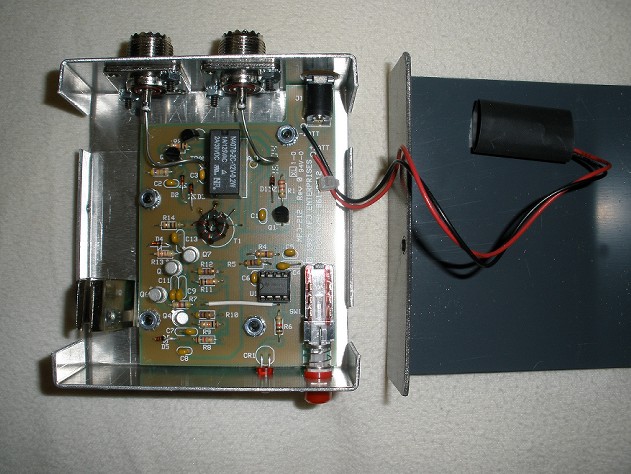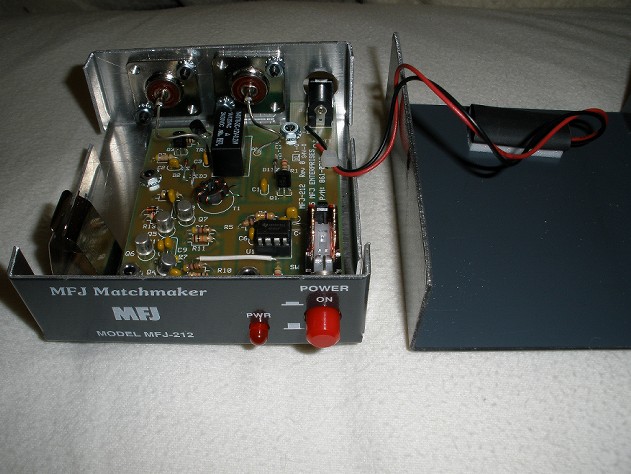|
If you use a transmatch, you GOTTA try this cool accessory out. Your finals and friends on the bands will thank you. For under $100, it just might pay for itself in finals. Buy the AC adapter or operate it off 9 Volt snap battery for field day. I have put this into use on Long Island at my second station shared with KC2VLI on my "all band dipole". After just one demonstration, Don mastered the adjustment technique, and he is a new ham.
What does it do?
It is a noise bridge set to 50 Ohms with a switch through relay to allow it to remain in line during transmit. It allows you to precisely adjust your transmatch without putting a signal on the air.
How does it work?
Set your transceiver to receive, preferably in such a way that it will not transmit RF (turn VOX off). Using previously logged settings of your transmatch knobs, set it for the band in use with the correct antenna connected. Push the red power button on the MFJ-212 to activate it. You will hear a pulsing white noise similar to a steam choo choo train. Tune the knobs on your transmatch to minimize the test noise signal. You will be surprised how sharply the knobs on your transmatch tune this way. When you get the noise less than S2, turn off the MFJ-212. This will put the MFJ unit into pass through mode to avoid damage in transmit to the bridge. The internal switch through relay takes care of the switching when you operate it in this way. The manual suggests that there is a fail safe circuit that will save the unit if you forget to operate the power switch as directed. I did not tempt fate, but it is nice to know that it is there. In all cases, I found the SWR provided by this procedure to be less than 1.2:1 on my Ten Tec 1225 power meter when I went to transmit, even on 10 Meters. By the way, the MFJ-212 allowed me to find a transmatch solution on 10 Meters that I was unable to adjust at all before by any method.
Pluses:
- Really easy to use.
- No signal on the air when adjusting transmatch.
- Very precise adjustment possible.
- Quicker adjustment possible after you become familiar with technique.
- No strain on transmitter finals
Minuses:
- As with any noise bridge, the frequency must be quiet to hear the best adjustment point. Remember you are adjusting for minimum test signal, typically below S2. You can tune off to a nearby frequency that is quiet. This will be OK for a common antenna. For a very narrow band antenna like a mobile whip, you may not get close enough to a solution due to the narrow band and high Q of such a shortened antenna. A compact stealth indoor loop also would be sufficiently sharp that it might be problematic if you cannot find a very close nearby quiet frequency.
- The manual has almost no information in it. Luckily, it is so simple to use, you don't need it.
- Someone else transmitting nearby (think field day) can damage your MFJ-212.
Alternatives:
- You can put your MFJ-259 antenna analyzer in line with switches. But you better be absolutely sure the switches are high quality, high isolation, and reliable or you could have a $300 mess.
- You can build a Ten Tec 1051 noise bridge kit and design your own switching system. I plan to use the Ten Tec 1051 (only $21) with my Yaesu FT950 employing the microtune jacks. The FT950 manual explains how to do this, so that no switching network is required.
Inside the MFJ-212 Noise Bridge:
The MFJ 212 manual has no schematic and is pretty sparse. I just got the chance to open it up and take some photos for you.
- First notice that a quality green G-10 fiberglass board is used, not a cheap brown epoxy paper board.
- There is a reed relay for switching the noise bridge in and out. The specs say there is a RF sense circuit that activates the relay in case you forget to switch it manually.
- The 8 pin mini-DIP IC is a 555 timer.
- Note there is liberal use of high quality metal can transistors instead of cheaper plastic case transistors. The power level does not require the metal can units, but generally these have real 2N.... numbers rather than the non-JAN house numbers which have looser specs.


|